Enhancing Home Aesthetics with Decorative Hangings
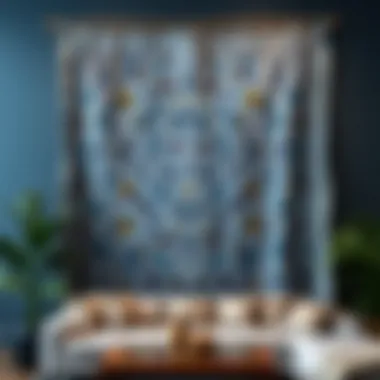
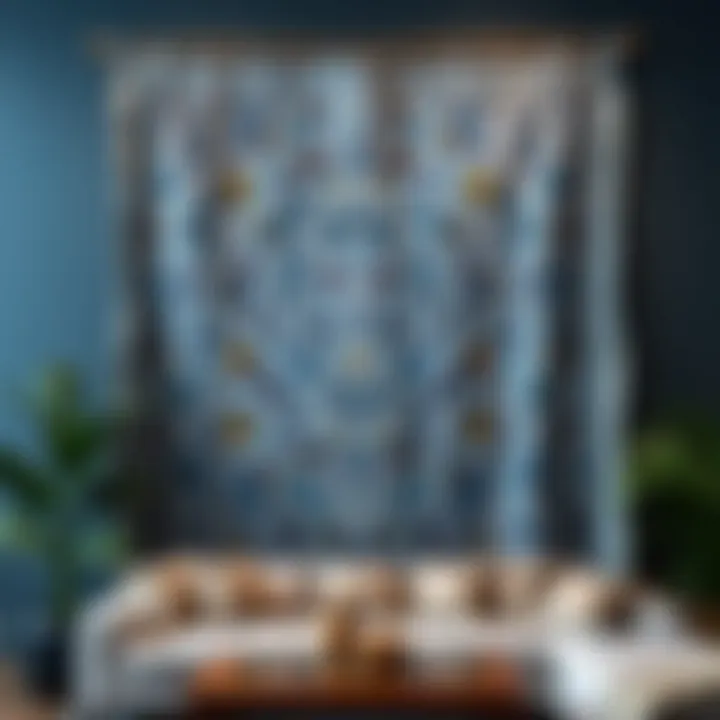
Intro
When it comes to home decor, the significance of decorative hangings often gets overshadowed by larger furniture and interior elements. Yet, these adornments serve as the finishing touches that can transform a bland space into a haven of style and personality. They do more than just fill walls; they tell stories, express tastes, and create atmospheres. Today, we’ll explore the rich world of decorative hangings, delving into various materials, design principles, and integrated approaches to elevate any home.
This exploration isn’t just for homeowners; designers, decorators, and all you DIY enthusiasts can benefit too. With a range of styles from antique to modern, decorative hangings have the power to tie a room together. They can evoke emotion, provoke conversation, and often reflect the homeowner's unique story. In this piece, you'll learn about different types of decorative hangings, effective ways to implement them, and useful tips for maintaining their beauty over time.
The popular belief may be that large canvases or striking tapestries are the only way to make your walls pop. However, the truth is far richer. Smaller pieces, collected items from travel, or even DIY projects can create a harmonious balance that complements the entire room. With the right guidance, you can master the art of mixing colors, patterns, and textures infused with personal charm.
As you journey through this article, consider how each suggestion could align with your own style and functionality requirements. Decorative hangings are not just about aesthetics; they also speak to who you are and enhance your living experience. Let’s dive deeper into the styles that define modern interiors.
Prelims to Decorative Hangings
Decorative hangings serve as the unsung heroes of interior design, weaving together aesthetics and functionality in any given space. With a myriad of styles, materials, and colors, these elements can profoundly affect the mood and appeal of a room. From a practical standpoint, they allow homeowners to express their personality and preferences, making a house feel more like a home. In this section, we delve into why decorative hangings are essential in home decor and the myriad benefits they bring.
Understanding the Role of Decorative Hangings
Each piece of decor adds a touch of life to blank walls and creates visual interest. A gallery wall adorned with various art pieces, for instance, can act as a vibrant talking point during gatherings. It’s not simply about filling space; it's about giving context and story to the surroundings.
Moreover, decorative hangings can influence spatial perception. Vertical designs tend to draw the eye upward, making a room feel taller, while horizontal pieces might broaden the space visually. Understanding these nuances aids decorators and homeowners alike in crafting an environment that resonates with comfort and elegance.
Historical Context of Decorative Practices
The tradition of using hangings goes far back in history, tracing the lines of culture and artistry across civilizations. For example, the grand tapestries of medieval Europe served not only as decorative elements but also provided warmth and insulation in drafty castles. This historical context emphasizes that decorative hangings aren’t merely superficial add-ons; they hold significant cultural and functional value.
In the modern day, the influence of these practices persists, albeit in varied forms. From Frida Kahlo's bold and expressive paintings, which embellish many contemporary homes, to the minimalist Scandinavian prints that echo simplicity and calm, decorative hangings now showcase a kaleidoscope of influences. Understanding this evolution helps us appreciate how contemporary hangings draw on centuries of tradition while still making bold statements in today's home design.
"Decorative hangings are not just adornments, they're conversations waiting to happen."
Embracing this rich tapestry of history and purpose equips designers, retailers, and homeowners with the knowledge to curate spaces that aren't only visually arresting but deeply meaningful.
Types of Decorative Hangings
Decorative hangings play a pivotal role in setting the tone of a home’s interior, making spaces feel complete and personalized. They serve not just as adornments but also as focal points, enhancing the overall aesthetic and functionality of rooms. Understanding the diverse types of decorative hangings is crucial for home designers, decorators, or anyone looking to spruce up their living space.
Wall Art and Paintings
Wall art and paintings are among the most popular forms of decorative hangings. They can range from classic portraits to abstract canvases, offering a myriad of styles to choose from. A well-chosen piece of art can speak volumes, reflecting the personality of its owner.
The impact of wall art is more than visual; it often evokes emotions and memories. Think about how a serene landscape may transform a lively living room into a calming sanctuary. Selecting art also requires a keen eye for color and style, ensuring the piece complements existing decor.
- Tip: To create a cohesive look, choose pieces that share a common color palette or theme. Gallery walls—where multiple artworks are arranged together—can tell a story and add a vibrant layer to the room's narrative.
Textile Hangings
Textile hangings bring warmth and texture to walls, making them a favorite among decorators. From elegant fabric wall coverings to rustic quilts, textiles can soften a space and add depth. They offer several practical benefits, including sound absorption, which makes them particularly useful in larger, echo-prone rooms.
Additionally, textile hangings can range widely in patterns, colors, and materials—making them versatile choices for any room. They can easily be interchanged with the seasons or your changing tastes, allowing for flexibility in interior design.
- Example: Consider using a handwoven rug as a wall hanging to introduce a cozy, bohemian touch to a formal setting.
Framed Photographs
Framed photographs serve as personal narratives, capturing memories and milestones threaded through the fabric of life. Unlike generic wall art, these pieces often hold a sentimental value, invoking emotions every time one walks by. A collection of framed photographs can create a charming display, narrating stories of vacations, family gatherings, or cherished friendships.
When arranging framed photographs, consider mixing different frame styles and sizes to generate an eclectic vibe. Alternatively, matching frames can create a more polished and harmonious look.
"Photography is the art of making memories tangible."
Macramé and Tapestries
Macramé and tapestries have made a substantial comeback recently, becoming staples in both bohemian and contemporary decor styles. Tactile and intricate, macramé adds a handmade touch to the home, invoking a sense of craftsmanship that can be both grounding and aesthetically pleasing.
Tapestries, on the other hand, often showcase beautiful designs or themes, making them perfect pieces for creating a focal point.
- Pro Tip: Hang a macramé piece in a well-lit corner to enhance its textures and intricacies, casting unique shadows that change throughout the day.
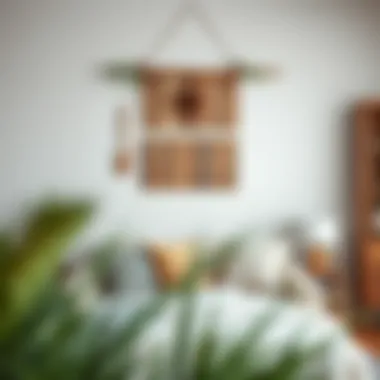
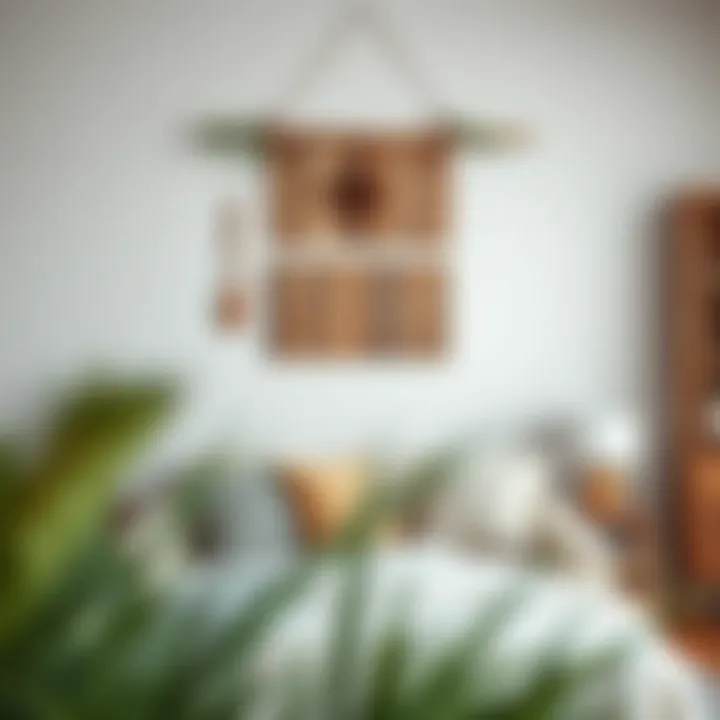
Mirrors and Reflective Hangings
Mirrors serve more than just a function; they are decorative elements that can visually enlarge a space and introduce a sense of brightness. A large, ornate mirror can serve as a statement piece, drawing the eye and providing depth to a room. Reflective surfaces can amplify natural light, crucial in smaller or darker areas of the home.
When choosing mirrors, consider the style of your decor. A vintage mirror can add character to a modern space, while sleek, minimalist designs align well with contemporary aesthetics.
- Observation: Mirrors can also be part of an art installation, where the interplay between reflection and decor creates an engaging focal point.
Understanding these various types of decorative hangings equips homeowners and designers alike with the knowledge to make informed decisions that enhance the aesthetic appeal of a living space. The right choice of hangings can elevate not only the visual appeal but also the emotional atmosphere of a home.
Selecting Materials for Decorative Hangings
Choosing the right materials for decorative hangings is crucial not only for aesthetics but also for functionality and longevity. The materials you select can dictate the overall atmosphere of a space, affecting how it feels and looks. Different materials bring different textures, colors, and character to a room, making the choice of material almost as important as the design itself.
When selecting materials for decorative pieces, it is important to consider factors such as durability, maintenance, and how well they align with your overall home decor. Whether you go for rustic wood, sleek metal, or soft textiles, each material has its distinct properties and appeals to different tastes. Here’s a closer look at some of the popular options available.
Wood and Natural Materials
Wooden hangings bring a touch of warmth and earthiness that few other materials can replicate. Whether it’s reclaimed barn wood or finely finished oak, wood offers a versatility that can suit various styles—from rustic farmhouse to modern minimalism. It pairs well with natural fibers and other organic materials.
Moreover, wood is often sustainable, especially if sourced from responsible suppliers. One important thing to consider is the finish; natural wood finishes will show the grains and knots, offering character and uniqueness in each piece. Here are some points to think about when selecting wood or natural materials:
- Durability: Hardwoods like maple or cherry are more durable than softer woods and last longer in a home setting.
- Style compatibility: Wood can easily fit into various design themes. Make sure its style complements your existing decor.
- Maintenance: Different finishes require different levels of upkeep; oiled finishes may need reapplication over time.
Metal and Industrial Elements
Metal decorative hangings are synonymous with modern and industrial design. These materials come in various finishes such as brushed nickel, rusted iron, or polished brass, allowing for a wide range of stylistic options. They provide a sleek and contemporary touch, and the reflective qualities of metals can help to brighten a space by bouncing light around.
However, metal can also add a bold statement. The following factors are essential when considering metal elements:
- Corrosion resistance: When opting for metals, consider whether they need to be treated to withstand humidity, particularly in kitchens or bathrooms.
- Weight and support: Metal hangings can be hefty, so ensure your wall supports can carry the weight.
- Color and finish versatility: Various finishes can create dramatically different looks; consider how your choice will blend or contrast with other decor.
Canvas and Fabric Considerations
Textiles offer a softness and warmth that can be very inviting. Canvas paintings or fabric hangings can bring color and texture, softening harder surfaces in a room. They are also lightweight and easy to install, making them a fantastic option for renters or those who like to frequently change their decor.
When choosing fabric materials, keep in mind:
- Color fastness: Fabrics may fade over time, especially with direct sunlight.
- Texture pairing: Mix different textures to create depth (for instance, pairing a velvet cushion with a canvas print).
- Wash ability: Some textiles require special cleaning methods, so consider maintenance requirements.
Glass and Crystal Accents
Glass and crystal add an element of elegance and luxury to decorative hangings. Whether through stained glass panels or crystal embellishments, these materials can significantly enhance the luminosity of a space. Glass pieces can refract light in stunning ways, casting beautiful patterns and making spaces feel larger and airier.
Considerations for glass and crystal materials include:
- Fragility: Always think about placement; glass decorations may not be suitable for high-traffic areas.
- Cleansing needs: Dust and fingerprints can show easily, so maintenance is crucial.
- Integration with other materials: Balancing glass with heavier elements can create eye-catching contrasts.
Color Theory and its Application
Color theory serves as the backbone of effective interior design, particularly when it comes to decorative hangings. Understanding the nuances of color can significantly enhance the way we perceive a space, molding the atmosphere and influencing emotions. Decorative hangings, from wall art to textile pieces, must align with color schemes that not only resonate with personal taste but also elevate the functionality and essence of a room. A solid grasp of color theory enables designers, homeowners, and DIYers to choose the right hues and create visual coherence, making it an integral part of the decorative journey.
Impact of Color on Space Perception
The colors we choose for decorative hangings can manipulate the perception of space in the home. For example, soft, light colors like pale blues or soft whites can make a small room feel more spacious, airy, and open. On the other hand, darker colors can add coziness but may shrink a room's perceived size. Color also has an emotional impact; warm tones can evoke feelings of comfort and warmth, while cool tones often promote relaxation and calm.
Some key points regarding how color impacts space perception:
- Light vs. Dark: Bright colors reflect light, helping to create an impression of larger space, whereas dark colors absorb light, creating intimacy.
- Warm and Cool Colors: Warm tones (reds, oranges) can make a space feel inviting yet busy, while cool tones (blues, greens) create a serene atmosphere.
- Contrast: Using contrasting colors can enhance architectural features, making them pop, but must be applied carefully to avoid overwhelming the space.
"Color is the keyboard, the eye is the hammer, the soul is the piano with the strings." – Wassily Kandinsky
In practical terms, one might consider introducing soft mustard-yellow textile hangings in a neutral-toned living room. This would create warmth while ensuring the space doesn't feel cramped.
Creating Harmony with Color Schemes


When it comes to decorative hangings, creating a harmonious color scheme is crucial for maintaining visual balance and flow throughout the home. A thoughtfully curated palette can unify disparate elements, tying together different textures, patterns, and styles without appearing chaotic or mismatched.
To establish harmony, consider the following techniques:
- Monochromatic Schemes: These utilize variations in lightness and saturation of a single color. This technique offers a clean and cohesive look.
- Analogous Colors: Choosing colors that are next to each other on the color wheel, like blue, green, and teal, creates a serene feel without being overly simplistic.
- Complementary Colors: Pairing opposite colors on the color wheel can add vibrancy and drama, such as using orange hangings against a blue wall.
- Neutrals as Anchors: Incorporating neutral colors allows brighter hues to shine without overwhelming the senses, providing a visual resting point and enhancing the overall decor.
Integrating Decorative Hangings into Home Design
Decorative hangings are not simply about beautifying walls; they play a significant role in defining the character of your home. When integrated thoughtfully, these adornments enhance the overall aesthetic, creating spaces that feel welcoming and harmonious. Homeowners and designers alike need to consider how these hangings can complement existing décor while expressing individual style. The purpose of this section is to elucidate the various strategies involved in blending decorative hangings into your home design, thereby enriching the living experience.
Layering with Existing Decor
Layering decorative hangings can transform a flat, uninspired wall into a dynamic surface that captivates the eye. This process involves placing various types of hanging items—like paintings, photographs, and textiles—at different heights and arrangements. Keeping a cohesive color palette is essential, acting like glue that binds the components together. For example, mixing a vibrant abstract painting with muted woven wall hangings can create visual interest without overwhelming the space.
To achieve a balanced look, consider these points:
- Varying Size: Use a combination of large and small pieces to break monotony. Large artworks can anchor a space, while smaller items can create a rhythm around them.
- Textures: Incorporating different textures, such as smooth wooden frames alongside soft fabric, adds depth to the decor.
- Consider Theme: Ensure that your hangings align with the overall theme of the room, whether that’s contemporary, rustic, or eclectic.
The right combination of textures and sizes can weave a story that reflects your personality, making your home feel uniquely yours.
Establishing Focal Points
Every well-designed room generally benefits from focal points—elements that draw the eye and anchor the space. Decorative hangings can serve as these focal points, establishing where the attention is directed. A large tapestry or an oversized piece of art can attract attention as soon as one enters a room.
To effectively establish focal points using hangings, keep these strategies in mind:
- Strategic Placement: Hang key pieces at eye level to ensure they stand out. This will naturally guide the viewer's gaze.
- Contrast: Utilize contrasting colors between the hanging and wall to emphasize the artwork or textile. For instance, a dark frame against a light wall can create a striking effect.
- Grouping: Sometimes, assembling multiple small items in a gallery-style arrangement can act as a unified focal point. This method can elevate even the simplest display into an intriguing focal area.
Balancing Symmetry and Asymmetry
The concept of balance is fundamental in home design, especially when integrating decorative hangings. Choosing between symmetry and asymmetry can greatly affect the atmosphere of a room. Symmetrical arrangements offer a sense of order and formality, which can be calming. For instance, two identical pieces on either side of a fireplace can create a harmonious look.
On the flip side, asymmetrical arrangements can inject a sense of movement and a more casual feel. Here are tips to strike the right balance:
- Mix Symmetry and Asymmetry: While having a large, centered piece, you can flank it with smaller, varied items on the sides to soften strict formality.
- Visual Weight: Consider the visual weight of different pieces; a larger, busier painting might necessitate more minimalistic elements nearby to prevent overpowering the space.
- Layering Depth: By combining both techniques, a wall can have an interesting depth—filling blank spaces while remaining engaging.
Integrating decorative hangings into your home design isn’t just about sticking things on the wall. It requires thoughtful consideration of layering, establishing focal points, and balancing elements. These aspects ensure that your decorative choices resonate with the space's overall design and enhance rather than clash with the existing themes.
DIY Decorative Hanging Projects
Creating your own decorative hangings can be a rewarding endeavor. Not only do DIY projects allow for personal expression, but they also present an opportunity to inject a bit of your own personality into your home decor. It’s those unique touches that transform a house into a home. As you embark on these artistic ventures, the benefits are plenty:
- Cost-effectiveness: Many DIY projects can be completed with minimal investment, particularly when you repurpose items you already own.
- Personalization: Crafting something from scratch means you can tailor it to your exact vision—color schemes, sizes, and styles that reflect who you are.
- Satisfaction: There is an undeniable joy in completing a project with your own hands, creating something beautiful and functional in the process.
However, DIY hanging projects come with their set of considerations. Planning is crucial. Think about where you will place the hanging, the overall theme of your room, and the materials you have at hand. A well-thought-out piece can enhance the aesthetic of a space significantly.
Crafting Wall Art
When it comes to creating wall art, the sky's the limit. You might try your hand at a canvas painting, or perhaps opt for a mixed media approach combining different textures and materials. One approach gaining traction is using local flora and fauna—pressed leaves and flower petals can bring an organic feel to your creations.
- Materials to Explore: Think about using different paint types, textured mediums, or even adding three-dimensional elements for depth.
- Techniques: Experiment with abstract designs or geometric patterns using painter’s tape for clean lines. Utilizing sponges or brushes of various sizes can add an interesting flair as well.
Ultimately, wall art is not just about decoration; it’s also about storytelling. Each piece can evoke a feeling or memory, making your interior space more inviting, if you do it right.
Creating Customized Textile Pieces
Textile art is another popular area where DIYers can shine. From fabric hangings to embroidered designs, textiles can add warmth to a room. The possibilities are endless—think about creating wall hangings from woven fabrics or turning old shirts into patchwork creations.
- Choose Your Fabrics: Cotton, linen, or natural fibers resonate well for a cozy feel, while synthetic materials can offer a modern touch.
- Crafting Techniques: Consider methods like quilting or macramé, which have made a significant comeback lately; they add a tactile quality that’s appealing to the eye.
- Dyeing: Don’t overlook the impact of color! Tie-dye, batik, or even simple fabric paint can customize your textile piece entirely.
The beauty of textiles is their versatility; they can be as casual or sophisticated as you wish, adapting seamlessly to various aesthetics.
Upcycling Old Frames
If you find yourself with a stash of old frames gathering dust, now is the time to breathe new life into them. Upcycling can transform these forgotten items into stunning decor without breaking the bank. A simple coat of paint or a bit of embellishment can work wonders.
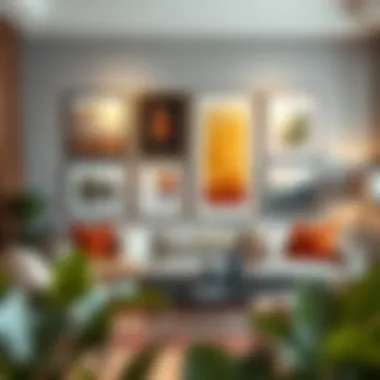
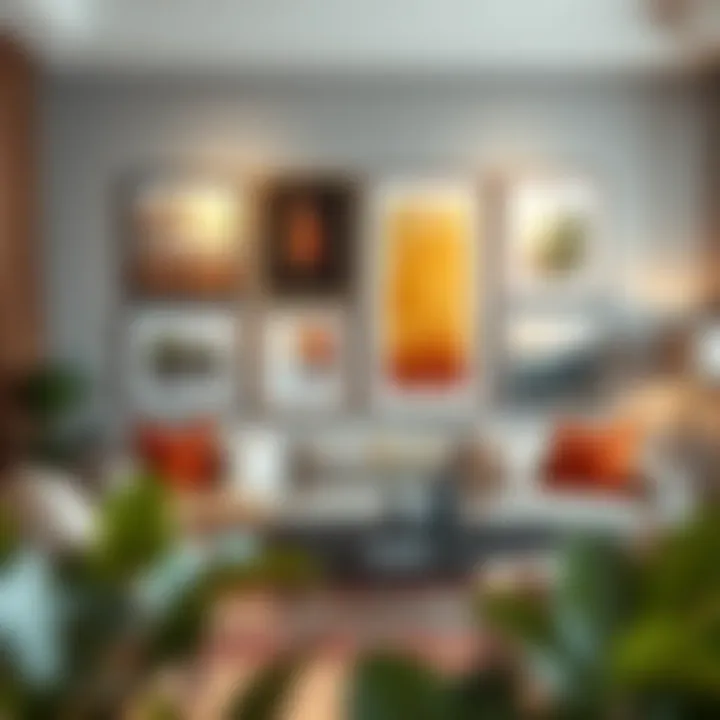
- Layering: Combine different size frames to create a gallery wall; consider mixing painted finishes for added interest.
- Decorative Accents: Think outside the box—add decorative paper, fabric swatches, or even small objects like feathers or shells inside the frames for a shadow box effect.
- Quotes and Typography: Use frames to showcase meaningful quotes. Hand-lettering phrases can give your frames a personal touch, and it’s easy to switch out as your tastes evolve.
Upcycling not only contributes to a stylish ambiance but also promotes sustainability, which is becoming increasingly important in modern decor conversations.
In summary, engaging in DIY decorative hanging projects offers a wealth of creative opportunities for everyone. Whether it’s crafting wall art, textiles, or breathing new life into old frames, the process is both enjoyable and fulfilling. Plus, you’ll end up with unique pieces that reflect your distinct style, bringing a personal touch to your living space.
"Creativity takes courage." – Henri Matisse
For more inspiration on DIY projects, check out platforms like Pinterest or forums on Reddit where many share their creative journeys and ideas.
Current Trends in Decorative Hangings
In recent years, decorative hangings have undergone a remarkable evolution, reflecting broader shifts in design preferences and lifestyle choices. This section delves into the current trends shaping the landscape of decorative hangings, offering insights into how they not only enhance aesthetics but also support values such as sustainability and individual expression.
Eco-Friendly Materials and Practices
The call for environmentally conscious living has seeped into nearly every facet of design, including decorative hangings. Today, many homeowners and designers are turning to eco-friendly materials that minimize environmental impact. Options such as reclaimed wood, organic cotton, and fabrics dyed with natural processes are becoming increasingly popular. These choices aren’t just kind to the planet, they also add a unique story to each piece. For instance, a macramé wall hanging made from recycled fibers can serve as both an art piece and a conversation starter.
"Sustainability is no longer a trend; it’s a lifestyle choice reflected in our homes."
When selecting materials, consider the sourcing practices of companies. Choosing brands that prioritize sustainable practices not only supports local economies but ensures the longevity of the decor itself. Additionally, trends point towards upcycling—transforming old fabrics and materials into new decorative elements. For example, turning a discarded fabric swatch into colorful tapestry can freshen up a space while reducing waste.
Mixing Minimalism with Bold Elements
As the pendulum of design swings between minimalism and maximalism, today’s trend leans into mixing these two aesthetics. Homeowners are now combining sleek, understated pieces with bold colors and patterns, creating a dynamic visual experience. This approach allows for personal expression without overwhelming the space, striking a perfect balance.
Consider using a simple white wall as a canvas for a bright abstract painting or a set of unsophisticated frames filled with vibrant images. The key is to maintain minimalistic decor that acts as a backdrop to more eye-catching elements. These contrasts emphasize each piece, bringing attention to the intricacies of both styles.
While integrating this trend, it’s essential to think about scale and proportion. Oversized art pieces can successfully coexist with delicate fabrics when arranged thoughtfully. Designers emphasize that when mixing styles, maintaining some level of cohesion is critical—whether through complementary colors, shapes, or textures.
In summary, the convergence of eco-friendliness and a mix of design philosophies is reshaping how decorative hangings are perceived and utilized in home designs today. Embracing these trends not only enriches one’s living environment but also contributes to a more conscientious approach to decor.
Maintenance of Decorative Hangings
Maintaining decorative hangings in the home isn't just a matter of cleanliness; it's an essential factor that significantly contributes to the overall aesthetic and longevity of your decor. There's a lot of personality and expression tied into these hangings, and preserving their beauty is vital. Clean and well-maintained pieces not only enhance the visual appeal but they also reflect a homeowner’s care for their space. Additionally, neglecting maintenance can lead to damage that may require costly repairs or replacements, thus emphasizing why it's worth dedicating time and effort into this aspect.
Cleaning Techniques for Various Materials
Cleaning methods for decorative hangings can differ drastically depending on the materials employed. Here’s a breakdown of how to effectively clean some common materials:
- Wood: For wooden hangings, such as framed art or rustic displays, dusting them with a soft cloth regularly is essential. When deeper cleaning is necessary, a solution of water and mild soap can be wiped on a damp cloth but make sure to dry them properly afterward to avoid any water damage.
- Fabric and Textiles: Fabric hangings like tapestries or fabric wall art need special attention. Ideally, they should be vacuumed using an upholstery attachment to remove dust. If there's a need for more thorough cleaning, spot treatment with a gentle fabric cleaner is advisable; however, always test in a small area first.
- Metal: Metal pieces, such as sculptures or wall hangings, can be cleaned with a soft, dry cloth to avoid scratching. Using a little bit of vinegar or a specialized metal polish can remove tarnishes but take care to follow the manufacturer’s instructions.
- Glass and Acrylic: For mirrors or glass hangings, using window cleaner or a vinegar-water solution on a microfiber cloth works wonders. Just remember to avoid anything abrasive, as it could lead to scratches.
"Preventative care is always easier than remedying a mishap down the line."
Preserving Artwork and Textiles
Art and textile preservation is perhaps the most important aspect of maintenance, ensuring that these cherished pieces remain vibrant and intact for years to come. Here are some practical strategies to consider:
- Control Your Environment: Keeping your hangings in a stable environment — away from direct sunlight, humidity, or temperature fluctuations — can make a world of difference. Use UV-filtering glass for artwork to reduce fading.
- Regular Inspections: Frequently checking the condition of your hangings allows you to catch any potential problems early. Look for signs of wear, discoloration, or damage, especially in textiles that may attract moths or other pests.
- Caution with Framing: When framing artwork, selecting archival quality materials is crucial. Acid-free mats and UV-protective glazing can prevent damage over time, keeping the colors true and the paper from degrading.
- Proper Storage: For textiles not currently displayed, rolling them with acid-free tissue is better than folding them, which can lead to creases or permanent marks.
By following these maintenance tips for cleaning and preservation, you can ensure that your decorative hangings not only look their best but also continue to add charm and character to your home for many years.
Ending and Future Perspectives
As we wrap up our journey through the world of decorative hangings, it’s worth taking a moment to reflect on their significance within the realm of interior design. Decorative hangings are more than mere embellishments; they serve as expressive elements that articulate personal style, invoking feelings, and setting the tone within our living spaces. In today’s fast-evolving home decor landscape, the role of these decorative elements is shifting. Homeowners are no longer just hanging artwork or textiles for aesthetics; they are curating environments that tell stories, enhance well-being, and respond to their dynamic lifestyles.
The Evolving Role of Decor in Homes
In recent years, the understanding of what decor means has broadened. The once rigid definitions of style have given way to fluid expressions of identity. Individuals are now blending traditional and contemporary pieces, creating a living canvas that showcases their unique narratives. Decorative hangings play a crucial role in this transformation, offering homeowners a canvas to display personal experiences. From family portraits to travel memorabilia, these hangings are windows into one’s life story.
Moreover, as people become increasingly environmentally conscious, the choices regarding decorative hangings have changed dramatically. Many are opting for sustainable materials and upcycled designs. This shift emphasizes the importance of mindful consumption and the desire to connect with the environment. The aesthetics of a room are intertwined with the values that the decor represents.
As decor trends continue to evolve, factors such as psychological impact and social connections will likely become even more influential. For instance, research has shown that art and personal memorabilia can evoke comfort and joy, suggesting that not only does decor beautify a space, but it can also enhance mental well-being. Therefore, understanding the psychological effects of decorative hangings can lead to more thoughtful selections that foster a positive ambiance.
Inspiration for Next Steps
Now that we’ve unpacked the intricacies of decorative hangings, consider how you can incorporate this understanding into your own home. Here are some practical steps to take:
- Evaluate Your Space: Take a good look around your home. What stories do your walls tell? Are there hangings that spark joy or provoke thought?
- Experiment with Layering: Don’t hesitate to mix various styles, materials, and shapes. Layering can create depth, intrigue, and a more personalized aesthetic.
- Embrace DIY: Channel your creativity by trying your hand at DIY projects. From painting your own art to creating unique fabric hangings, the possibilities are limitless.
- Stay Informed on Trends: Follow design blogs, social media accounts, and websites like Houzz or Pinterest to keep a pulse on emerging styles and techniques.
- Engage with Community: Join forums or groups on platforms like Reddit to exchange ideas, gain feedback, and find inspiration.
Ultimately, the journey of enhancing one's space through decorative hangings is both personal and ever-evolving. As we continue to navigate changing tastes and styles, the importance of thoughtful and intentional decor choices becomes clear. Through mindful engagements with decorative elements, we can create homes that truly reflect who we are.















